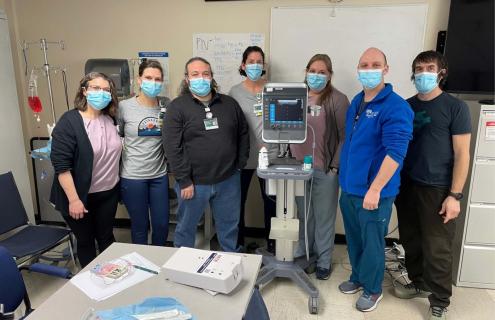
“I should warn you: I’m a hard stick.” It’s a phrase many lab technicians, nurses, and doctors have heard from patients when it is time to insert a needle into a vein. But did you know there’s a way to get an intravenous IV set up on the first try? In February, APD nurses learned how to use ultrasound technology to increase vascular access, specifically intravenous (IV) access.
“IVs used to be the realm of physicians. Ultrasound used to be exclusive to radiology. Now it’s moved into a number of areas, including nursing. It’s where we are headed in the modern healthcare arena,” said Matthew Bryant, MS, CRNA, nurse anesthesiologist and vice chair of Surgery at Alice Peck Day.
Some Emergency Department (ED) staff have been trained on ultrasound vascular access. ED nurses typically provide back up for the Medical/Surgery nurses but, with increasing volumes in the ED, four additional nurses — two from Med/Surg and two from the ED — will be trained using the technology.
“It’s the first class here at APD,” said Kristie Foster, BSN, RN, ED clinical manager/educator. “Currently 60% of staff are trained in ultrasound and it’s our goal to get everyone there.”
All four nurses have done their prep work before today’s class, which included online training modules. Today it is time for in-person training.
Bryant starts the class with a PowerPoint, just to get everyone on the same page with terminology, but the nurses are mostly hands-on with a vascular access ultrasound training arm.
“Typically an IV starts by feel. When you can’t feel a vein, you can’t access it,” Bryant says. “Ultrasound gives you eyes below the surface.”
Using his own arm, he shows nurses how the density of scanned objects displays on the screen — bone and fat are white, muscle and connective tissue are gray, and blood vessels and nerves are black. When a vein is found, it’s time for some math, matching the depth of the vein with the angle of approach for the needle.
Using the training arm, nurses put their learning to work. It starts with learning how to set up the probe.
“Gel is your friend. It transmits sound. The more gel you use, the less pressure you need,” Bryant said. There are some tricks to master, for example, too much gel might cause the probe to drift. And the probe is sensitive; tiny movements make a big difference on the screen.
“Take the time to scan, if you have it. Scan bilaterally before committing,” Bryant advises. “Large vessels are easy to identify. Track the vessel to locate best entry point. This will feel unnatural to you when you first start. Be gentle on yourselves. Take it slow. The goal is to understand the concept and improve your success rate.”
Ultrasound vascular access might be necessary when the patient is overweight (veins will be deeper), struggling with substance use disorder (veins might have scar tissue), or age 85 and older (veins are shallow and fragile). In general, the technique decreases the number of difficult IV starts which, in turn, increases patient satisfaction.
“This has been a skill I’ve wanted to learn for a long time,” said Randy McSwain, RN, Medical/Surgical. “I loved the class and I love the way Matt and Kristie teach.”